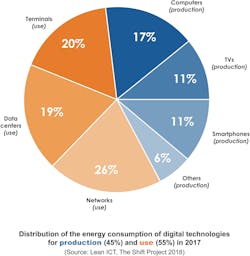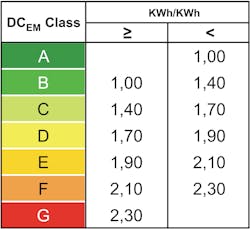What Can’t Be Measured Can’t Be Improved
KPIs for Sustainable ICT Infrastructures
ETSI ATTM is developing standards to support sustainable and efficient ICT infrastructures and created the Global KPIs defined with Operational Technical indicators named Objective KPIs. These KPIs allow communities as industry to justify the level of sustainability over time (sliding months) in order to have activities, a life in short, for a more sustainable planet.
ICT infrastructure, including both network infrastructure and IT infrastructure, represent more than 35% of digital energy consumption worldwide and 2% of worldwide CO2. Today’s network demands and insatiable consumer usage have likely increased these percentages, therefore it’s more important than ever to create standards that help guide industry improvements. (See Figure 1.) Source: https://theshiftproject.org/en/gdp-energy/
As such, operators must learn how to thrive and reduce these impacts simultaneously. Toward that end, ETSI has published several Global KPIs to help operators progress in reducing environmental impacts during operations.
Defining Global KPIs
To that purpose, ETSI defined a series of standards, both for Telecommunication Operators use (ES series 205 200) and for European use (EN series 305 200) that define global KPIs and their user guide (TS series 105 200). Other Global KPIs may be defined in the future using the same scheme as defined below. These KPIs do not refer to benchmark values but to measurements during operations.
Global KPIs reflect the conformance of a network or a single or group of ICT sites to a defined policy for sustainability. It is driven by a master indicator (e.g., Energy Efficiency, Carbon Intensity) combined with several weighted bonuses. A policy defines which consideration is given to what bonus. This policy is not fixed; it can be defined by users of a standard.
The Global KPIs are designed to measure only a specific aspect of the considered sites. They cannot be used to compare sites or group of sites unless combined with other relevant indicators such as climatic conditions, purpose, and business objectives.
These standards may also be considered as a contribution to the application of ISO 50001 in relation to the development of policy for the continuous improvement of energy management and will accelerate:
- The availability of operational infrastructure architectures and network implementations that use energy more efficiently.
- The definition and attainment objectives for other environmental aspects of sustainability for operational broadband networks.
Global KPIs are presented as two figures, the annual energy consumption including all energy sources among which the renewables, and a performance indicator represented as a banded value. The definition and the number of these bands are part of the sustainability policy. The performance indicator of a group of sites is the weighted average based on the master indicator, of the performance indicator of each site constituting the group.
For energy management DCEM KPI (See Figure 2.), the considered bonuses are the use of renewables and the reuse of energy. The master KPI for networks is the energy spent for a given amount of transmitted data for one year. For ICT sites, the master KPI is the energy spent during one year for a given energy consumed by ICT equipment.
For carbon management DCCM KPI (See Figure 3.), the considered bonuses are the use of local low-carbon energies and the reuse of heat in neighboring sites and the master KPI is the carbon intensity of the master KPI of energy management.
The Energy efficiency master KPI for ICT sites is similar to PUE (standardized in CENELEC EN 50600 series and ISO/IEC 30134 series) except that it does not take into consideration energy input from waste heat in cogeneration.
Rewarding Local Implementations for a Greener World
The bonuses reflect local implementations efforts by the operator. They do not include financial bonuses such as certificates of origin. They do help in building a greener world by providing incentives to building renewable and lower carbon emitting sources as well as reusing waste heat.
Considered energies and their related greenhouse gas emissions are all those that enable ICT operations, including during fault conditions (e.g., ICT equipment, cooling, power, safety and security infrastructures) coming from all sources (e.g., grid, district cold and heat, diesel, CHP). Energy consumption for other uses (e.g., offices, shops) should be excluded from all calculations. Measurement points for energy consumptions are those documented in international standards series cited above.
When applied to ICT sites, these standards only consider ICT site infrastructures enabling the hosting of ICT equipment. They do not address other layers such as performance of ICT equipment, performance of usage of available processing power, and layers related to final service delivered (e.g., processing power required per itemized outcome) or overlay layers (e.g., energy consumption per itemized outcome). When applied to networks, they only consider equipment under common governance with the owner of the network.
“Global KPIs reflect the conformance of a network or a single or group of ICT sites to a defined policy for sustainability. It is driven by a master indicator (e.g., Energy Efficiency, Carbon Intensity) combined with several weighted bonuses. A policy defines which consideration is given to what bonus. This policy is not fixed; it can be defined by users of a standard.”
The rationales for choosing the aforementioned bonuses are:
- Use of renewables: Reduces the impact on fossil resources of the planet, although this does not reduce the amount of used energy. A weighting factor has been added so that other factors can still be considered even when 100% of the used energy is renewable. We only consider locally produced renewable energy or energy coming from a dedicated power plant over the grid so that it is possible to differentiate efforts coming from actual implementations to those coming from financial operations or delegated to grid producers.
- Reuse of energy: All incoming energy is converted to heat that warms the atmosphere but can be reused on neighboring sites to reduce their energy consumption and direct/indirect greenhouse gas emissions.
- Use of low carbon energy sources: the same way renewables are considered, there is an incentive to use local energy sources that are less carbonated than the public grid delivered at the considered site.
A sustainability policy is defined based on annual energy consumption of sites. Weightings for bonuses are associated with consumption ranges. They can be set to allow full consideration of the bonus to no consideration at all. For instance, when reporting DCEM, a telecommunications company would set network access sites full consideration to use of renewables and none to energy reuse and would consider a bigger attention for Data Centers to energy reuse and a maybe a lower one to use of renewables. This company would consider similar settings for DCCM when considering use of less carbonated energy sources and heat reuse.
Use of Renewables
Differently from international REF standards, use of renewables as defined by these standards are like those defined by the shift project for greenhouse gas emissions in its “net zero initiative” by clearly differentiating efforts designed to reduce one’s own fossil footprint to efforts to reduce others’ footprint. Use of certificates of Origin may be considered as the latter and are not accounted for in this standard. We also do not consider green energy mix of grids for several reasons, among which we want to reward local implementations efforts, and the definition of “green” varies depending on countries.
Differently from international ERF standards, reuse of energy is considered at the reuse point since we do not consider losses in the transmission from sites to energy reuse point(s) as any kind of performance.
The published standards are the ETSI EN 305 200 series, and some related user guides in the ETSI TS 105 200 Series.
- ETSI EN 305-200-3-1 and TS 105 200-3-1 as known DCEM for energy management of ICT sites.
- ETSI EN 305-200-2-1 for complementary information in special cases for DCEM.
- ETSI EN 305-200-2-2 and TS 105 200-2-2 for energy management of fixed networks.
- ETSI EN 305-200-2-3 and TS 105 200-2-3 for energy management of mobile networks.
- ETSI EN 305 200-3-2, as known as DCCM for carbon management of ICT sites, fixed and mobile networks.
For more information, please email [email protected] or visit https://www.etsi.org/technologies/energy-efficiency. You can also follow them on Twitter: https://twitter.com/ETSI_STANDARDS, Facebook: https://www.facebook.com/etsi.standards, and LinkedIn: https://www.linkedin.com/company/etsi/.
ETSI ATTM is developing standards to support sustainable and efficient ICT infrastructures. ETSI ATTM created the Global KPIs defined with Operational Technical indicators named Objective KPIs. These KPIs allow operational actors (communities as well as industry) to justify the level of sustainability over time (sliding months) in order to have activities, a life in short, for a more sustainable planet.
About the Author
Olivier Bouffant
Vice Chair of ETSI technical committee ATTM (Access, Terminals, Transmission, Multiplexing)
Olivier Bouffant is Vice Chair of the ETSI technical committee ATTM (Access, Terminals, Transmission, Multiplexing). He has more than 20 years of experience in passive infrastructure, cabling systems, and FTTx studies working for Orange Innovation.
He is also involved in standardization about communication infrastructure at national (AFNOR), European (ETSI ATTM, CENELEC TC 215), and international levels (ISO/IEC JTC1 SC25) where he is Chair of ETSI/ATTM/AT2 and AFNOR UF215 commissions.
For more information, please email [email protected] or visit https://www.etsi.org/technologies/energy-efficiency. You can also follow them on Twitter: https://twitter.com/ETSI_STANDARDS, Facebook: https://www.facebook.com/etsi.standards, and LinkedIn: https://www.linkedin.com/company/etsi/.
ETSI ATTM is developing standards to support sustainable and efficient ICT infrastructures. ETSI ATTM created the Global KPIs defined with Operational Technical indicators named Objective KPIs. These KPIs allow operational actors (communities as well as industry) to justify the level of sustainability over time (sliding months) in order to have activities, a life in short, for a more sustainable planet.
Guillaume Gérard
ETSI technical committee member ATTM (Access, Terminals, Transmission, Multiplexing)
Guillaume Gérard works at Orange for promoting sustainability in Orange’s data center strategy. He is participating in several standardization committees: ETSI, CENELEC, and a coordination committee for green data centers, where he contributed to standards related to engineering and sustainability for ICT sites. Together, with the eG4U NGO, he wrote global KPI assessing conformance to a sustainability policy, among which ETSI DCEM for management of energy of ICT sites and is continuing to work on similar standards.
For more information, please email [email protected] or visit https://www.etsi.org/technologies/energy-efficiency. You can also follow them on Twitter: https://twitter.com/ETSI_STANDARDS, Facebook: https://www.facebook.com/etsi.standards, and LinkedIn: https://www.linkedin.com/company/etsi/.
ETSI ATTM is developing standards to support sustainable and efficient ICT infrastructures. ETSI ATTM created the Global KPIs defined with Operational Technical indicators named Objective KPIs. These KPIs allow operational actors (communities as well as industry) to justify the level of sustainability over time (sliding months) in order to have activities, a life in short, for a more sustainable planet.





